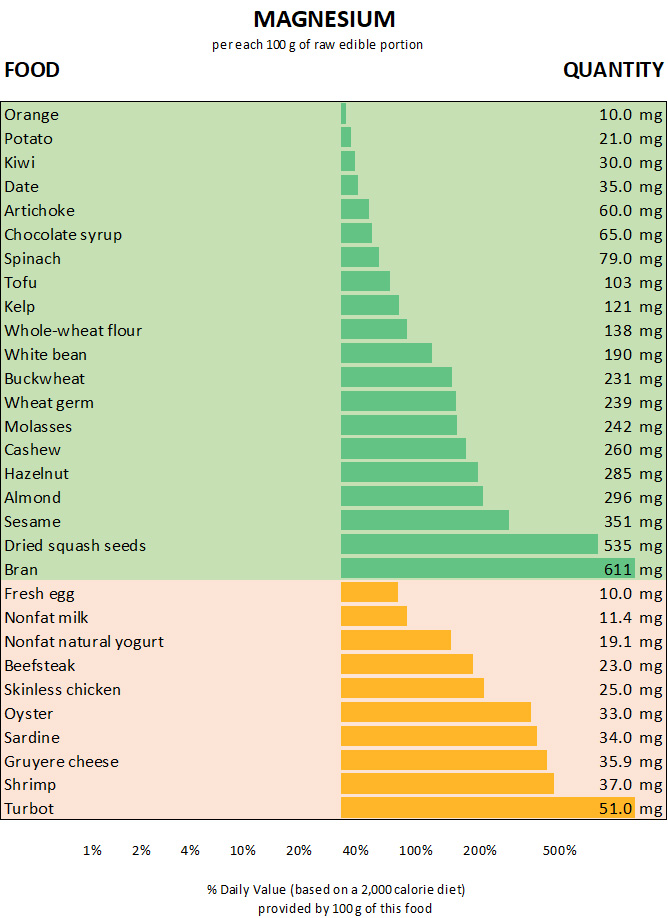
Magnesium-rich foods come in many varieties. This mineral element is also available as a supplement and is widely used in laxatives and antacids. Magnesium is vital for the proper process of more than three hundred enzymes. These enzymes perform various chemical reactions within the body, such as nerve and muscle functions, the building of healthy bones, and blood sugar regulation. Getting this all-important mineral from the consumption of magnesium-rich foods is also essential because it acts as an electrical conductor that aids in muscle contraction and ensures a healthy and steady heartbeat—the human body stores magnesium in the bones and various other tissues.
Chemical composition of magnesium: mineral element
Sources of magnesium for the human body: wheat bran is the wealthiest product in magnesium; it contains 20 times more than meat or milk. However, because of phytates, only a portion is absorbed. Seeds are excellent sources of magnesium, including wheat germ, sesame, oil-bearing nuts, and legumes.
Absorption: 30% to 50% of what is taken is absorbed into the blood.
- Facilitators of absorption: food proteins, lactose from milk, and vitamin D, among other factors.
- Inhibitors of absorption: excess calcium or phosphorus. Like with calcium, the phytates from whole grains and the oxalic acid from certain green leafy vegetables partly decrease magnesium absorption. Despite this, these foods remain an excellent magnesium source since they contain many minerals.

The function of magnesium: This mineral is involved in forming bones and teeth, catalyzes energy-producing reactions within the cells, facilitates the transmission of nerve impulses, and is interested in muscle relaxation, as opposed to calcium, which activates contraction.
Magnesium deficiency symptoms: muscle spasms that may become generalized, known as tetania.

Magnesium supplement side effects: When magnesium is taken orally, there are usually no side effects, especially if taken following your physician’s professional advice. For instance, a 350 mg dose is likely safe for most adults. However, some people may experience vomiting, diarrhea, nausea, upset stomach, and other mild symptoms. This element can become unsafe when taken in amounts larger than 350 mg. Extreme doses of magnesium can build up within the body, leading to severe complications, including confusion, irregular heartbeat, slowed breathing, low blood pressure, coma, and eventually death.
Magnesium deficiency causes: cases of alcoholism, serious diarrhea, and kidney disorder can produce a lack of magnesium due to lack of absorption or increased loss through the urine or feces.
Magnesium loss during the processing of foods: This mineral is not affected by heat. Any loss is due to the dissolution of its salts in cooking water. The following magnesium-rich foods chart is an excellent resource for those wanting to get more of this all-important mineral via food sources instead of supplementation. The chart below answers my question: “What foods are rich in magnesium?“
Magnesium-Rich Foods List

DISCLAIMER: All content on this website is presented solely for educational and informational objectives. It would be best to not rely on the information provided as a replacement for advice, diagnosis, or treatment from a qualified medical expert. If you are pregnant, nursing, or have any preexisting medical concerns, you should talk to your doctor before using any herbal or natural medicines.
REFERENCES
- George D. Pamplona-Roger, M.D. “Encyclopedia of Foods and Their Healing Power.” George D. Pamplona-Roger, M.D. Encyclopedia of Foods and Their Healing Power. Trans. Annette Melgosa. Vol. 1. Chai Wan: Editorial Safeliz, 2005. 400. Print. [magnesium-rich foods]
- Magnesium and osteoporosis: https://www.ncbi.nlm.nih.gov/pmc/articles/PMC3775240/
- PubMed: https://pubmed.ncbi.nlm.nih.gov/ – Great for medical research articles.
Last update on 2025-06-04 / Affiliate links / Images from Amazon Product Advertising API



